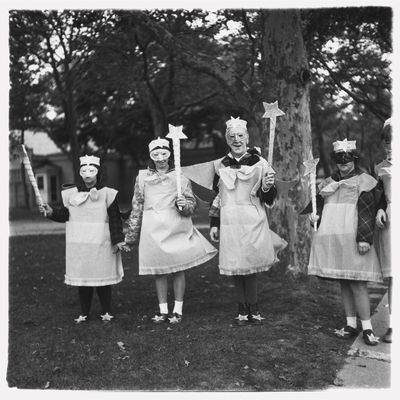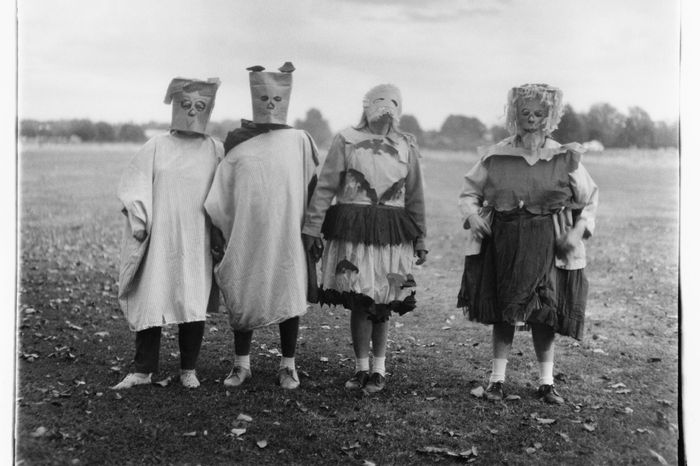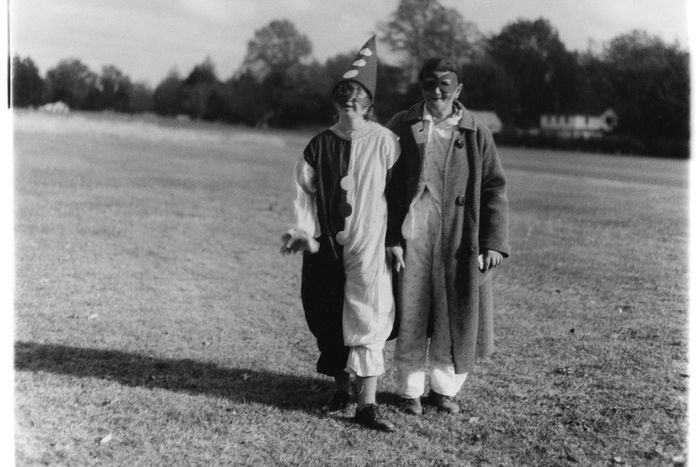
It is reductive and tiresome to write about Diane Arbus and immediately bring up her death. It also seems almost impossible not to, for a couple of reasons. First off, she ended her life at 48, as her creative powers, still developing, reached a new level of intensity. (Who can avoid imagining what greatness lay ahead?) And second, that new creative development had led her into more and more transgressive, difficult terrain with each passing year. She was continually upping the daily dosage of emotional charge, chasing an ever-more-dramatic synaptic response, and eventually, the pop-psychologist in us suggests, her system just couldn’t handle it.
In her final two years, starting in 1969, Arbus found a subject to which she kept returning: institutionalized developmentally disabled people, most of them with the distinctive facial features of Down syndrome. Some are kids, others older. Quite a few of the photographs were made during Halloween celebrations, and the subjects have dressed up, often with masks. Most are framed like family snapshots: people standing outside, solo or in little groups, facing the camera. They seem to be on outings, usually in a field or in front of some trees. Fifty-one of these pictures were collected in a monograph called Untitled, published in 1995, and those photographs, plus another handful never before exhibited, have just gone up at David Zwirner’s gallery on 20th Street.
Early in her career, Arbus quit the studio fashion photography she’d been making with her husband, Allan, with the words “I can’t do it anymore. I’m not going to do it anymore.” (That moment opens Arthur Lubow’s superb biography of Arbus, published in 2016.) She spent the next two decades on the creative trail, and as she got into the “Untitled” series, she thought she’d had it. “FINALLY,” she wrote, “what I’ve been searching for.” Jeffrey Fraenkel, the dealer who has handled her estate for many years, has remarked that a pair of recent exhibits — her formative early solo work last year at the Met, and now this one at Zwirner — bracket her career much as these two remarks do.
What she found near the end of her journey was, even now, intimidatingly complex. The people in these photographs are hard for some observers to look at, whether out of fear or mere discomfort. (As if Down syndrome were infectious, that we might catch something.) Yet the subjects themselves seem pretty happy. They’re dressed up, either for Halloween or just for a day out. Most are smiling for the camera. The ones who are in conventional clothes rather than costumes have, most of the time, taken care with their appearance. They’ve chosen their outfits to present a look to the world, same as you or I do. And Arbus has lit them in a way — Fraenkel pointed this out at the opening of the show — that’s extremely hard to describe, one that I don’t think I’ve seen anywhere else: outdoors, usually under a leaden sky, with a little bit of fill-in flash but not a full-on blast of light. Neil Selkirk, who has done all of the posthumous printing from Arbus’s negatives and made most of the prints in this show, says she had been wrestling with an overpowered electronic flash throughout much of the ’60s, and finally had it under control. It probably wasn’t always dusk when she took these photos, or about to rain, but it seems that way.
“Diane Arbus Untitled” is at David Zwirner through December 15.







